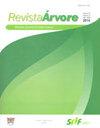不同克重和压力下松木接头的抗剪强度
IF 0.8
4区 农林科学
Q4 FORESTRY
引用次数: 0
摘要
粘合剂的主要作用是促进材料之间的粘合,并提供流动性和填补接缝之间的空隙。当涉及到胶合层压木材结构的执行时,诸如克重和粘合压力等信息是基本的。在这个意义上,本研究的目的是评估使用冷固化的单组分聚氨酯胶粘剂在三种不同的克水平(150 g.m-2、200 g.m-2和250 g.m-2)下,在0.7 MPa和1.0 MPa两个压力水平下,在单面涂敷时的抗剪强度。测定表观密度,得到4个块/密度组,共4次重复。此外,还对剪切试验后试件的破坏率进行了分析。采用2x3因子块随机设计进行统计数据分析,分析克重和粘结压力对木材强度和破坏的影响,检验数据的均匀性和正态性,然后进行方差分析(ANOVA)。结果表明,无论是重量还是压力水平,关节的强度都没有受到影响。木材的耗损率较低,平均在35%以下。本文章由计算机程序翻译,如有差异,请以英文原文为准。
SHEAR STRENGTH OF Pinus sp. JOINTS BONDED WITH DIFFERENT GRAMMAGES AND PRESSURES
ABSTRACT The main function of the adhesive is to promote adhesion between materials, as well as provide fluidity and fill in the gaps between joints. Information such as grammage and bonding pressure is fundamental when it comes to the execution of structures in glued laminated wood. In this sense, the objective of this study was to evaluate the shear strength in compression of bonded joints using a one-component polyurethane adhesive with cold curing at three different gram levels, being 150 g.m-2, 200 g.m-2 and 250 g.m-2, with spreading on a single face, applied at two pressure levels, 0.7 MPa, and 1.0 MPa. The apparent density was determined, and with that, four blocks/density groups were obtained, which comprised four repetitions. In addition, the percentage of failure in the specimens after performing the shear test was analyzed. Statistical data analysis was carried out adopting a randomized design in a 2x3 factorial block to analyze the effects of grammage and bonding pressure on wood strength and failure The homogeneity and normality of the data were tested, and later the analysis of variance (ANOVA). The results showed that the joints’ strength was not affected, both for weight and pressure levels. As for the wood failure percentage, the values obtained were low, with averages below 35%.
求助全文
通过发布文献求助,成功后即可免费获取论文全文。
去求助
来源期刊

Revista Arvore
FORESTRY-
CiteScore
1.00
自引率
0.00%
发文量
32
审稿时长
4-8 weeks
期刊介绍:
A Revista Árvore é um veículo de comunicação científica da Sociedade de Investigações Florestais – SIF. O jornal é de acesso gratuito, revisado por pares, que publica bimestralmente trabalhos científicos originais no campo da Ciência Florestal. As áreas temáticas para publicação são: Ambiência e Conservação da Natureza, Manejo Florestal, Silvicultura e Tecnologia da Madeira e Utilização de Produtos Florestais.
A política editorial visa manter alta conduta ética em relação à publicação e aos seus funcionários, rigor na qualidade dos artigos científicos, seleção de revisores qualificados, respeito profissional aos autores e processo de tomada de decisão imparcial. A Revista Árvore publica artigos apenas em inglês.
Artigos de revisão podem ser publicados se houver uma discussão relevante resumindo o estado da arte sobre o assunto. A revisão estrita da literatura não é aceita.
 求助内容:
求助内容: 应助结果提醒方式:
应助结果提醒方式:


